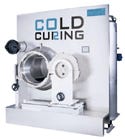Washing Process Offers Alternative to Oven Technique for Postcuring of Silicone Parts
September 3, 2007
Originally Published MPMN September 2007
BREAKTHROUGHS
Washing Process Offers Alternative to Oven Technique for Postcuring of Silicone Parts
|
Silicone parts are loaded into the ColdCuring cleaning chamber and are washed with liquid carbon dioxide. |
After molding or extrusion, small silicone parts for use in medical applications must undergo a postcuring process in order to reduce the amount of volatile residue, and thereby meet safety standards. Traditionally, the oven technique has been used for postcuring silicone, but not without challenges. Silicone is highly cohesive, and during the oven postcuring process, parts will form “grapes” and stick to each other, making it difficult to achieve a homogenous treatment of parts. Overcoming sticking usually requires increased human handling and the introduction of chalk, both of which can sacrifice cleanliness.
The ColdCuring system from Nanon a/s represents a step forward from the oven technique, says Franck Gauthier, the company’s vice president of sales and marketing. “The uniqueness of the process is based on using a sophisticated washing machine,” he explains. “The washing occurs with liquid carbon dioxide, which has low surface tension and ensures uniform wetting of the silicone.”
Parts are loaded into the cleaning chamber where liquid carbon dioxide penetrates into the polymer matrix, dissolves, and washes away low-molecular-weight residues, including volatiles and impurities. Extracted oils are collected from the distillation vessel and kept in a closed system from which they can be safely disposed. After the process, the purified parts are separated from the solvent by depressurization, leaving dry parts ready to be packaged.
The company provides full in-house treatment of silicone products, as well as installation of the ColdCuring equipment directly on a customer’s production line.
ColdCuring provides several benefits, according to the company. For one, ColdCuring takes less time than the oven technique: 50 minutes of ColdCuring is equivalent to 4 hours of postcuring in an oven. Also, reduction of volatiles and oligomers can be achieved to less than 0.005% for cyclic siloxanes D4–D20. No slit-healing or cut-healing is required with the process, meaning parts can be molded and cut during the curing stage without repolymerization effects during the postcuring stage. Furthermore, it’s possible to postcure components that incorporate heat-sensitive materials since the process occurs at room temperature.
An additional feature of the ColdCuring process is the use of autoclavable bags to load and unload silicone parts from the cleaning chamber. The same bags can be used several times. Gauthier explains that using autoclavable bags will improve the process by limiting silicone parts to one bag for the entire production process. After the molding or extrusion line, the parts are transferred to the autoclave bags, which are then used for ColdCuring. After unloading, the bags can be directly labeled, obviating the need for any additional packaging. “It limits human contact and ensures that the parts will be dust free and easy to monitor during production,” Gauthier says.
The ColdCuring process may also possess environmental advantages over the oven technique, as there is no ejection of silicone volatiles into the air and all volatiles are collected for disposal. “In comparison, today with the use of the traditional oven technique, a company processing about 100 tons of silicone rubber per year will introduce about one to two tons of volatiles into the air, which will contaminate several kilometers of land around the factory,” Gauthier says.
Nanon a/s, Broendry, Denmark
www.nanon.dk
Copyright ©2007 Medical Product Manufacturing News
You May Also Like



